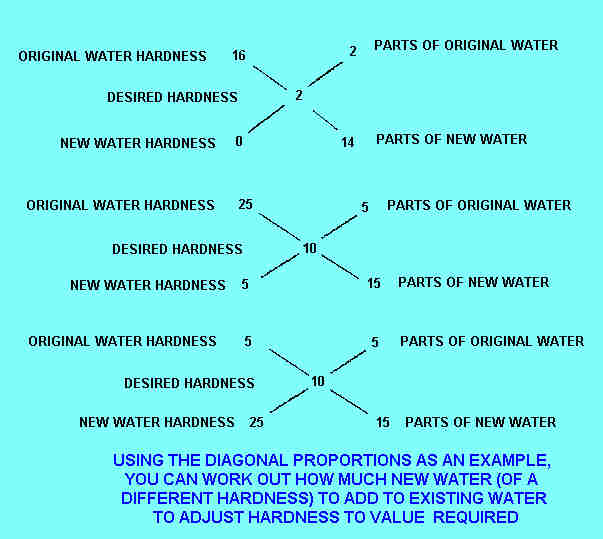HARDNESS
Hardness (and its opposite number, Softness) are really two
sides of the same coin.
Both are due to dissolved minerals in the water any, or
all, of which can have some effect on water quality and consequently on fishes, especially when
they are transferred between two bodies of water which have
widely differing characteristics without due re-acclimatisation. Development of fish eggs may also
be affected if the water chemistry is wrong; for instance,
Characins' eggs fair much better in soft acid water than is hard
alkaline conditions.
A generalisation is that most 'hard' waters are alkaline (pH
above 7) and 'soft' waters are acidic (pH below 7),
although you will find the odd exception to this - see More About pH.
The hardness of water depends on several factors:
- The atmosphere through which the original rain falls.
- The ground conditions on to which the original rain falls.
Hard insoluble rocks won't affect the water but soft
soluble rocks will. Calcium and magnesium salts are the
most common causes of hardness.
Once in the aquarium, these factors come into play:
- What chemical make-up the substrate/rockwork has or what ornaments
are present in the tank.
- How often regular partial water changes are undertaken
and the quality of the replacement water used.
- Whether any water condition changing materials are used
in the filtration system.
- Whether plants are used or not.
TESTING HARDNESS
Like pH, testing for hardness involves
mixing re-agents with a sample of aquarium water. Often, a colour
comparison chart is used to read off the 'degrees of Hardness' or
you may be required to count the drops used of the re-agent to
effect a certain colour change in the test phial. Again, at the
top end of the scale, there are electronic meters that can be
used.
ADJUSTING HARDNESS
 The simplest way is by dilution with a'softer' water. For instance, adding a litre of water of 5 degrees of hardness to a litre of water of 10 degrees of hardness
will give two litres of water of 7.5 degrees of hardness. By
mixing waters of suitable hardnesses in the correct proportions
any hardness value can be achieved.
The simplest way is by dilution with a'softer' water. For instance, adding a litre of water of 5 degrees of hardness to a litre of water of 10 degrees of hardness
will give two litres of water of 7.5 degrees of hardness. By
mixing waters of suitable hardnesses in the correct proportions
any hardness value can be achieved.
Ion exchange resins can be used as can
reverse-osmosis (R.O.) units.
Note that distilled, or R.O. water alone (neutral
in pH and no hardness) is unsuitable for fishkeeping.
Sometimes running water through a peat-filled
filter will soften water, as well as acidifying it, however the
degree of effect depends on the hardness/acidity of the original
water.
Sometimes, fish from soft waters need to be 'changed over' to harder water for convenience of keeping. This can achieved quite naturally with little stress to the fish.
Simply set up an aquarium with ordinary gravel substrate and fill with soft water, as required by the fish.
Over the next few weeks, the water in the tank will gradually harden due to the effect of the (probably) calcareous substrate.
In the meantime, make sure that partial water changes are made using the hard water to which you wish to acclimatise the fish.
Eventually, the fish will find themselves living quite happily in much harder water as will any offspring from spawnings who will be used to hard water immediately - without any re-acclimatisation being necessary.
Return to

 The simplest way is by dilution with a'softer' water. For instance, adding a litre of water of 5 degrees of hardness to a litre of water of 10 degrees of hardness
will give two litres of water of 7.5 degrees of hardness. By
mixing waters of suitable hardnesses in the correct proportions
any hardness value can be achieved.
The simplest way is by dilution with a'softer' water. For instance, adding a litre of water of 5 degrees of hardness to a litre of water of 10 degrees of hardness
will give two litres of water of 7.5 degrees of hardness. By
mixing waters of suitable hardnesses in the correct proportions
any hardness value can be achieved.